| List of articles | Contacts | Russian / Русский |
VARIETY OF COLOURS IN LEAVE SUCCULENTS
Peter Lapshin, Ph.D., Biology, Moscow, Russia
jornal «Sukkulenti / Succulents bilingual", №1(V5), 2003
Succulent plants are characterized by light and rather dim colours: grey-green, light blue-green, yellowish or brownish ones. It is connected with the abundance of sunshine in the natural habitat of these plants that they have to fight with.
Light colouring may be the consequence of the active secretion of cuticular wax: many Echeveria may become almost white (Fig. 1) (some Cotyledons, Kalanchoe etc). The greenish tint is as well often connected with the fact that surface layers of cells don't contain chlorophyll and other pigments, and as a result the colouring gets rather dull.
On the other hand plants (not only succulents) widely have forms with developed pigmentation (Fig. 1, 6, 7, 9, 11 on page 4 of the cover) usually of reddish or brown colour. Additional pigments (flavonoids, anthocyanins etc) are produced first as material to shield chlorophyll from destruction at too high sun radiation, besides for a kind of protection from its ultra-violet component. On the other hand, one of the most important functions of additional pigments is intercepting of photons in a yellow-green part of the spectrum, which is not used by the chlorophyll. As a result, the efficiency of photosynthesis increases.
Among all the variety of succulents one can be very interested in species and forms not of grey-light blue colouring, but very brightly coloured: red, brown, yellow hues and their combinations, having specks (Fig. 2), stripes (Fig. 3), various edgings or patterns of additional colours (Fig. 4).
One can often notice that such edgings or patterns appear only after irradiation by the sun rays, which didn't go through the glass, and so containing a small amount of ultra-violet component, which is otherwise stopped by the window glass. Synthesizing flavonoid pigments in the sun the plants protect themselves from harmful influence of large amounts of ultra-violet radiation, which causes various damages, first of all in photosynthetic and genetic systems of live cells.
Besides the species capable of getting their colour naturally, there are many the so-called "leaf-variegated" forms and sorts of plants - "variegata" (Fig. 2, 3, 4, 5, 8, 10, 12 on page 4 of the cover). Such forms can be seen in the majority of plants. Variegated forms usually have stripes or spots on their leaves, yellow or white edging, often of red hue. In the basis of such colouring there is some malfunction of chlorophyll synthesis on light-coloured sectors of leaves and stems of such plants.
Chlorophyll synthesis in the plant is defined both by a plastid genome and nuclear genome of a cell. More than 100 genes taking part in this process have been studied. Destruction of any of them leads to the cell not being able to synthesize the green pigment, or it appears to be not steady and is ruined. Consequently, the tissue, consisting of such cells will be light-coloured: yellow, white or reddish depending on presence or amount of additional pigments.
The offsets that lost the ability to synthesize chlorophyll can't exist independently and live at the expense of other green parts of the plant. Aeonium on Fig. 2 and Haworthia on photo 8 on page 4 of the cover have such offsets devoid of chlorophyll. Seedlings with a malfunction of chlorophyll synthesis live an ordinary life till they expend all the supplies of nutritious substances in the seed-lobe. They can be saved only with the help of grafting. (Though when carbon and vitamins in the nutritious solution are available they may successfully develop practically all the time on their own roots).
Variegated plants with a part of a leaf or a fragment of a stem devoid of chlorophyll (photo on the right on page 1 of the cover, photo 3, 7, 8 etc on page 2 of the cover) usually can function independently, but they, as a rule, grow more slowly than ordinary plants of the same kind and are more sensitive to the mode of lighting. (On the one hand, they are more light-requiring, as their load on the green tissues increases; on the other hand, one should take some precautions not to spoil the plant by the excess of light. Besides, it is often stated that the percentage of white sector depends on the lighting in comparison with the green one: more light – more white colour and vice versa).
If we would like to propagate variegated species, we can perform it only in a vegetative way, and often only by pedicellate cuttings not by leaves. If the plant is propagated from seeds and often by leaf, variegation disappears and normal green leaves are growing. What is it connected with? Offsets and leaves of plants develop from buds (meristems). A meristem usually consists of several hundreds of initial cells, which are constantly in division and give birth to the stem and leaves. Initial cells are placed in the meristem not in a chaotic way, but in a rather strict order, which is usually steadily preserved during all the time of a meristem existence. The choice of initial cells to form the stems or leaves or the way of performing depends on the systematic state of the organism on the whole.
Variegated offsets grow from meristems that have initial cells with some damages of a gene of chlorophyll synthesis (such cells are called chlorophyll imperfect). Thus, these meristems consist of cells with different genetic information. Such organisms are called chimeras. During the process of syngenesis there is a so-called dis-chimerization(as far as gametal cells are initially unicellular) and generation grown from seeds in the majority of cases will be a green one. But there are cases described when after interbreeding blooming variegated species there was splitting in the posterity according to Mendel's law for monohybrid interbreeding.
The pattern of white fragments on leaves – the arrangement of stripes, edging, relative proportion of white and green and other parameters depend on the correlation of chlorophyll imperfect and normal cells in the meristem, on their reciprocal arrangement inside it, and as well on the systematic position of the organism. Behaviour of a chimera because of changes in light intensity depends on which gene was damaged.
On page 4 of the cover one can see the collection of photos of such "non-green" species and forms. Seven of twelve are chlorophyll imperfect chimeras that gave normal specimen and the rest of the plants are normal including 2 hybrids. Let's pass over to the description of plants depicted there (descriptions follow the order of the photos):
1. Aeonium arboretum ssp. Atropurpureum Webb. Et Berth.
Very spectacular plants, noticeable not only for to their dark-red colour (up to black in "Schwarzkopf" cultivar), but also for their "palm-like" appearance. They have an upright stem with a rosette of leaves on the top. For "pseudo-palm" lovers who are pressed for space at home to grow dracaenas, cordylines or yuccas, Aeonium is a good way out, its average height being 10–20 cm.
Depending on the cultivation conditions the diameter of a rosette usually varies from 5 to 20 cm. The height of a plant depends on the age – 2 or 3-year-old plants are usually 20–30 cm high and 5-7-year-old in good conditions reach one-metre mark. The colouring of the foliage depends on the lighting – in winter these plants usually become green. During the period of active growth the leaves developing in cloudy weather will be green at first.
When cultivating these plants indoors at the Moscow's latitude the main problem appears to be an exceptional love of sun in this species, combined with a high growth speed and comparatively low succulence. All this creates some problems in winter period – weal lighting in winter doesn't give a chance to grow well, lack of watering leads to considerable loss of leaves, the most part of which falls down by spring. But in spring the rosettes recover.
2. Aeonium lindley f. variegata
This kind of Aeonium presents compact abundantly offsetting thick bushes covered by hairy grey-green succulent leaves. There are several similar in appearance species in cultivation: A. domesticum, A. tortuosum and A. lindleyi. All of them are very much alike and differ a little only by the size of their leaves, their tint and the degree of hairiness. You may see a variegated form of one of these species in the photo. There's no difference in cultivation from the normal plants. After de-shooting and on old bushes there may appear nonviable white offsets, which in spite of their attractiveness are no good and die quickly. The plants are not exacting, grow better under the scattered than bright light and don't like when their pot-mix is dry for a long time.
3. Anacampseros rufescens (Harv.) Sweet cv. "Sunrise"
This Anacampseros cultivar differs from the species by a yellowish leaves edging and by the tips of the young leaves. The leaves tip starting to grow in spring first get yellow then get a bright rosy edging then in winter bright colouring disappears and by spring this plant becomes totally green.
4. Ceropegia debilis ssp. woodii f. variegata
This species is rather widely spread; variegated form was first brought to Moscow from Holland. In cultivation there is practically no difference from usual plants, the only thing is that one should take great cautions while propagating this form: cuttings often rot.
5. Crassula ovata f. variegata
It is a plant from the Crassula group –the so-called "money-trees". On the photo one may see a variegated form. No problems in cultivation, but when watered abundantly it gets rotten more easily than a more widely spread Crassula portulacea. When grown under tough conditions together with cacti it grows very slowly. By leaf propagation the variegation disappears and one can see what species the plant belongs to in reality.
6. Echeveria cv. "Black Prince"
The leaves of this hybrid sort have got an unusual red-brown colouring. Quite similar in appearance is Echeveria affinis. Peculiarities of cultivation at the Moscow latitude are the following: when autumn comes it's difficult to manage to stop the plant from growing: the plant tries to grow in winter, as a result, the rosette begins to elongate and the plant sheds a lot of leaves. When cultivated under the room condition it doesn't have time to develop the flower in autumn then winter comes. Its advantage is easiness in propagation by leaves.
7. Echeveria cv. "Perle Von Nurnberg"
This is a hybrid sort of "gibbous-flowering" Echeveria – "The Pearl of Nurnberg" (E. x. gibbiflora "Perle Von Nurnberg"). This fairly attractive Echeveria has a nice rosy-bluish colour of leaves. Adult species with time form an upright stem and come to resemble some sort of a "palm-tree". The plant is very easy in cultivation; one can only wonder why it isn't widely spread in collections. Apparently, it's only a question of time.
8. Hawortia cymbiformis f. variegata
Hawortia cymbiformis has succulent chunky light-green leaves. It's a representative of the Asphodelaceae family. This species is widely spread, in the photo one can see its variegated chimera form. There's no difference in cultivation from usual plants of this type. Though it grows more slowly. Regularly there appear normal green and totally white offsets which should be eliminated.
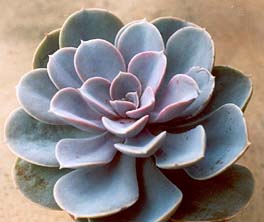
| 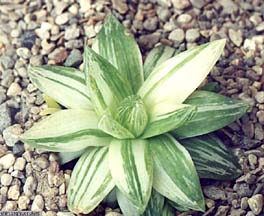
|
Рис. 11. Echeveria cv. 'Perle Von Nurnberg'
| Рис. 12. Haworthia cymbiformis f. variegata
| |
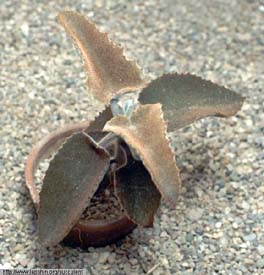
| 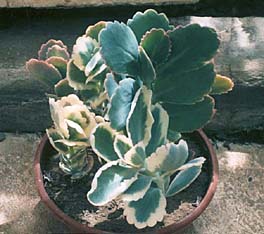
|
Рис. 13. Kalanchoe beharensis v. aureo aeneus
| Рис. 14. Kalanchoe fedtchenkoi f. variegata
| |
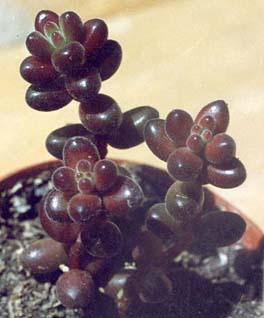 | ||
Рис. 15. Sedum stahlii
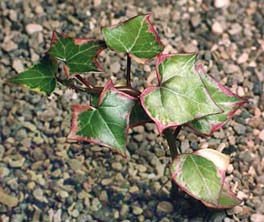 Рис. 16. Senecio macroglossus f. variegata
| |
9. Kalanchoe beharensis v. aureo aeneus
Young plants have got very beautiful brown velvety leaves. Later leaves become practically grey. The plant is up to a meter high and may be even higher. It's propagated by stem cutting and separate leaves. It isn't very demanding but in comparison with others Kalanchoe it grows more slowly.
10. Kalanchoe fedtchenkoi f. variegata
It's a widely spread small-leaved kind of Kalanchoe, absolutely undemanding in cultivation. It grows quickly and is propagated by leave and stem cuttings. Variegated form is reproduced only by cuttings. The plant in the photo is from the Nikitsky Botanical Gardens collection (Yalta, Crimea, Ukraine).
11. Sedum stahlii
It's a small plant with bright dark-red leaves the size of a pea. It has long sloping deciduous cuttings 20-30 cm long. It's propagated both by stem cuttings and separate leaves which don't stick to the stem strongly . The efficiency of propagation by leaves is close to 100%. The colour of the leaves varies depending on place of the plant, watering and state of pot mix. The brightest leaves belong to the plants that are grown in a poor mix and a small pot.
12. Senecio macroglossus f. variegata
It resembles ivy, doesn't it? only the leaves are succulent – juicy. Besides, the plant can wind round a support – a trick impossible for an ivy that sticks to rough vertical surfaces using their aerial roots. Their main difference from ivies is in their brilliant as if varnished and more succulent, often concave leaves. Variegated form is more spread – partially with yellow leaves – and its variety, able to become intensely rosy in the sun (see photo). They are undemanding in cultivation of you follow the rules of caring for succulent plants (not ivies!). These plants can't grow in the shade at all. In summer the open balcony is preferable, as well as a nutritious pot mix and abundant watering with a good drainage. In winter minimal watering is recommended, only at the lack of turgor. In winter most of the leaves fall down. The plant doesn't flower in usual conditions.
The genus of Senecio is from a vast family of Asteraceae. The representatives of the genus (more than 2000 species) are spread all over the world – from polar up to tropical zones. The genus is very diverse, includes many succulent types, the majority of which can be found in different regions of Africa and nearest islands.
Crowning it all one can say that the variety of succulent plants is so inexhaustible that any lover can find some species and forms for himself, forms that will satisfy his aesthetic notions. In further issues we are going to cover in detail the information about cultivating such plants.
|
|